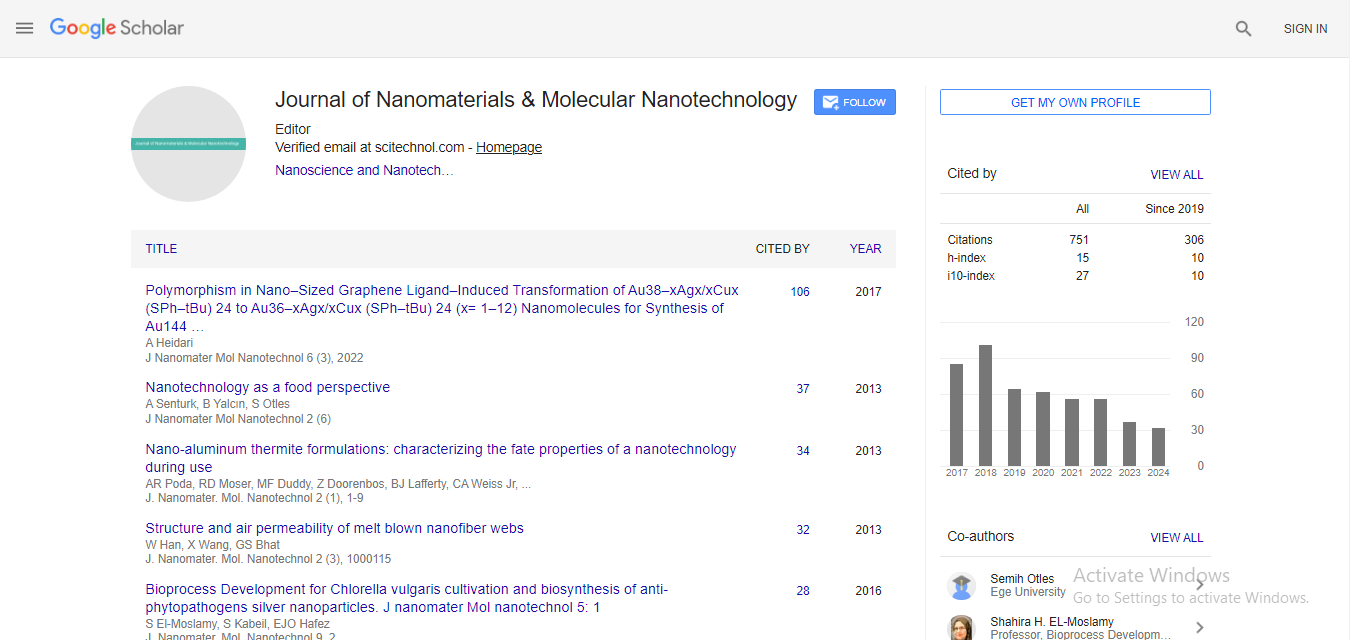Graphene based hydrogels for selective adsorption of water contaminants
Meisam Valizadeh Kiamahalleh, Said Al Siyabi, Azza Al Subhi, Mohammed Al Mamari, Shahd Al Qasmi, Mohammad Valizadeh Kiamahalleh, Amin Firouzi and Mohammad Al Abri
International Maritime College Oman, Oman
: J Nanomater Mol Nanotechnol
Abstract
The adsorption techniques have highly attracted the world’s attention for wastewater treatment due to their sufficient contaminant removal, low cost and free complexity steps. Amongst the recently developed adsorbents, graphene has enhanced the weakness of them due to its remarkable properties mainly, massive surface area of and tunable chemistry. This research presents a comprehensive study on graphene-based materials for wastewater treatment. By incorporating starch molecule as green spacer in graphene hydrogel, the interlayer spacing between graphene sheets was significantly increased, thereby providing more available pores and accessible surface area for adsorption of water contaminants. Scanning electron microscope (SEM), X-ray Diffraction (XRD) and Fourier Transform Infrared (FT-IR) were performed to illustrate the different physiochemical characteristics before and after adding spacer. Ultraviolet-Visible Spectroscopy (UV-VIS) was implemented to investigate the differences between the reduced Graphene Oxide Hydrogel (rGOH) and reduced Graphene Oxide Starch Hydrogel (rGOSH). The latter demonstrated a faster adsorption kinetics and higher capacity compared with the rGOH due the presence of starch molecules as a spacer, availability of the larger surface area and more porosity for up taking the foreign molecules. Organic and organometallic dyes with different charges (i.e. Methylene Blue (MB), Rhodamine B (RhB), Rose Bengal (RBg) and Tris (bipyridine) Ruthenium (II) Chloride (RuBpy)) were utilized to investigate the adsorption preference and selectivity of the hydrogels towards diverse chemistries of the sorbates. RuBpy with positive charge group due to strong attractive interaction with negatively charged hydrogel surface yielded the highest adsorption capacity and kinetics compared to the neutral MB and RhB. However, the negative RBg exhibited an insignificant adsorption profile. Such selective adsorption properties of the prepared hydrogel would create a broader range of opportunities for different applications (e.g. energy storage, controlled drug delivery, water treatment, etc.)
Biography
Meisam Valizadeh Kiamahalleh has received his Bachelor’s and Master’s in Chemical Engineering from Mazandaran University, Iran and Universiti Sains Malaysia. His MSc research project was in collaboration with Advanced Materials Research Center, SIRIM and dealt with synthesis, characterization and testing of carbon nanotubes-based nanocomposites for the supercapacitor electrode materials, which ended up with 6 ISI journal articles and 4 international conference papers. He has completed his PhD degree at the School of Chemical Engineering, The University of Adelaide, Australia. His PhD research work yielded two patents. His current research interests are mainly focused on designing and fabricating novel nano porous materials for the area of adsorption all the way from fundamentals to applications (i.e. in wastewater treatment, controlled drug delivery system and energy storage applications). Doing multidisciplinary research in nanotechnology is his passion and also a part of his academic path in International Maritime College Oman, where he is employed as a Senior Lecturer in the Process Engineering Department.
E-mail: meisam@imco.edu.om
 Spanish
Spanish  Chinese
Chinese  Russian
Russian  German
German  French
French  Japanese
Japanese  Portuguese
Portuguese  Hindi
Hindi 



